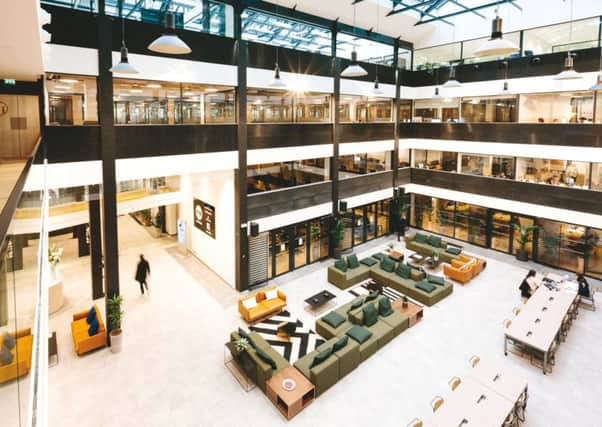Commercial property: Flexible office space set to double


According to a report by JLL, the sector is set to double in Edinburgh and Glasgow over the next five years.
The most recent sign of Scotland’s “flex revolution” has been the arrival of WeWork, which provides shared workspaces for businesses, in Edinburgh.
Advertisement
Hide AdAdvertisement
Hide AdThe New York-based operator is to open a 46,000sq ft space on George Street, accommodating up to 800 people.
The JLL report – Disruption or Distraction – predicts that flexible space will account for over 3 per cent of the total office stock in Edinburgh and 4 per cent in Glasgow by 2023.
The proportion may be small but those figures represent a steep rise.
“Flex” workspace providers currently occupy a modest 1.5 per cent of Edinburgh’s total office stock, comprising 376,000sq ft across the city centre.
The largest flex operator by some margin is Regus, who occupy six city-centre locations.
Like Edinburgh, Glasgow’s flexible office market is in its early growth stages. JLL estimate that the sector occupies 1.6 per cent of the city’s total built stock.
In 2018, Regus expanded its presence to two further locations at 1 West Regent Street and 100 West George Street, but Glasgow’s largest flexible workspace is operated by Clockwise, a regional provider offering both co-working and private offices, who opened at Savoy Tower in 2015.
Flex space tends to offer companies alternative solutions with no commitment required to either long-term leasing, facility management or major up-front capital expenditure.
Advertisement
Hide AdAdvertisement
Hide AdThese spaces are being used by individuals and SMEs, and increasingly, larger corporates, who are attracted by the increased flexibility, access to innovation and potential reductions in real estate.
Providing aspirational workplaces also allows companies to create a work environment that employees tend to find attractive.
JLL’s Ben Reed says: “Edinburgh’s status as one of the UK’s fastest growing tech hubs is reflected in the diversity of the city’s flex workspace offerings.
“However, supply remains the key stumbling block to any rapid growth in flex stock.
“Flex operators are typically looking for space north of 30,000sq ft, and there simply isn’t much of this size available at present.
“Flex has not yet truly disrupted the office market but is a response to the consumerisation of the workplace.
“Occupiers will play an increasing part in the future direction of the sector as operators, and increasingly landlords, become more aware of their customers’ needs and understand how they use spaces.
They will benefit from a greater choice in real estate options.”
Advertisement
Hide AdAdvertisement
Hide AdCommenting on the changing nature of the flex sector, JLL director Mike Buchan explains: “Rather than enter into long leases with landlords, flex operators are increasingly looking for ‘managed workspaces’, where the space is tailored to the individual occupier’s requirements and all occupational costs are wrapped together with a rentalised fit-out.
“Looking forward, we expect flex workspace stock to continue to expand.”